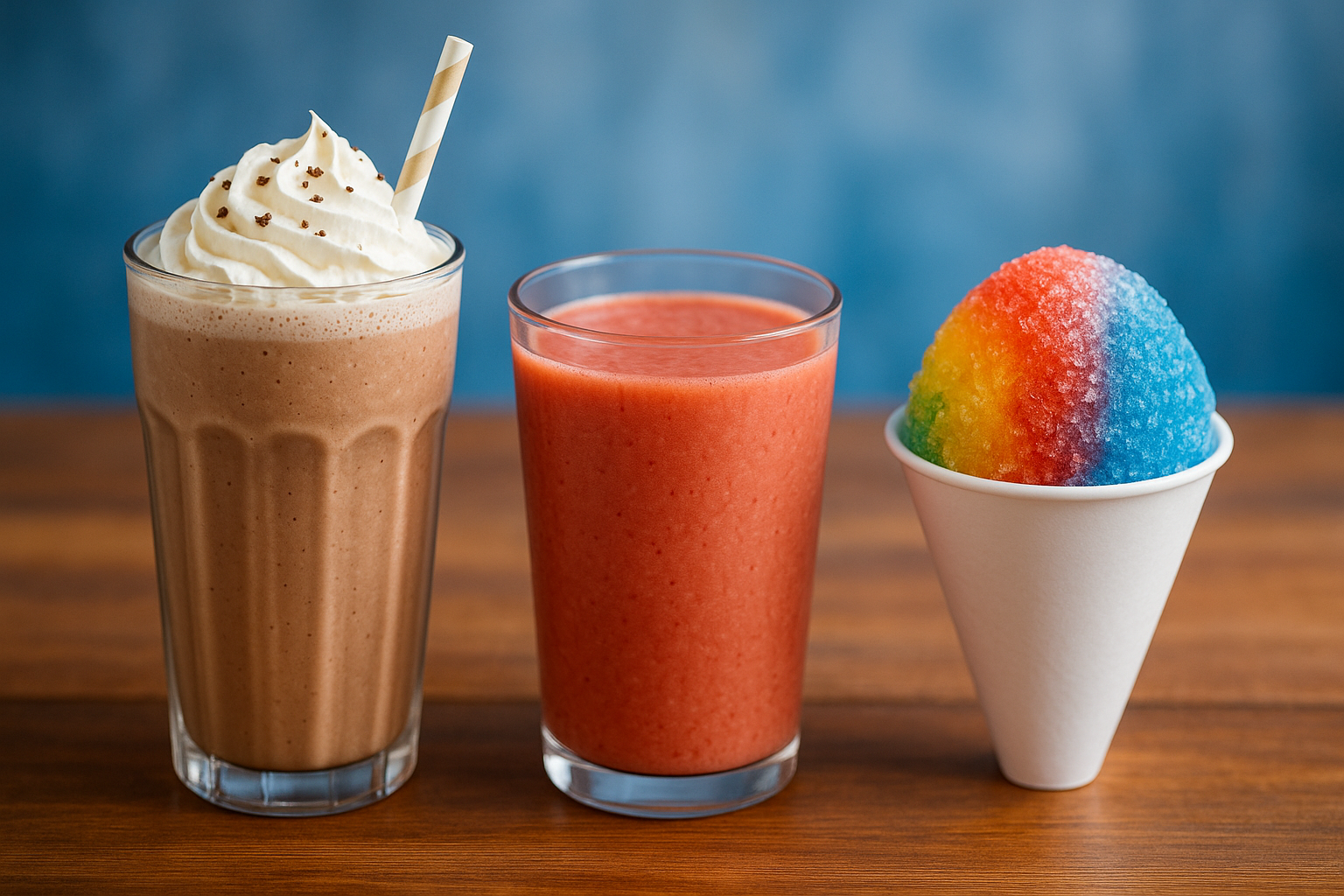Milkshakes and Smoothies and Sno-Cones - Oh My!
Written by Arbitrage • 2025-08-22 00:00:00

Few things satisfy a sweet craving on a hot day quite like a cold, creamy, brain-freezing indulgence. From the soda fountains of the early 20th century to today's smoothie bars and summer fairgrounds, frozen drinks have evolved into a wide range of treats with unique flavors and textures. Milkshakes, malts, concretes, frappes, floats, smoothies, and sno-cones may share the same chilly appeal, but each has its own story.
Milkshakes emerged in the late 1800s, originally as an alcoholic eggnog-like beverage. By the early 1900s, they had evolved into non-alcoholic ice cream drinks, popularized in soda fountains across America. A milkshake is typically a blend of ice cream and milk, blended until smooth, creamy, and sippable. The ice cream usually forms the base flavor of the drink, and then other flavorings can be involved, from syrups and extracts to fresh fruit. In New York City and other regions, a shake used to be known as a "frosted." John Philis, who co-owns the Lexington Candy Shop on Manhattan's Upper East Side, explained that a frosted float is a milkshake with an extra scoop of ice cream floating on top. (I'd try that!)
A special type of milkshake, the malted milkshake, or "malt," gained popularity in the 1920s after the Horlick brothers invented malted milk powder. Malted milk powder is an old-fashioned flavoring that combines malted barley, wheat flour (caution to the gluten-free crowd), and evaporated milk. It gives the drink a distinct toasted, almost nutty flavor that mentally transports you to a 1950s diner or drive-in.
Ice cream floats are the fizzy cousins of shakes. A scoop of ice cream (usually vanilla) is plopped into a glass of soda (usually root beer or cola, occasionally orange soda) to create a frothy, sweet, bubbly concoction. Floats trace their origins to the late 19th century. One popular origin story credits Robert McCay Green, who in 1874 reportedly ran out of ice for soda and substituted ice cream instead. The combination was an instant hit, spawning this classic treat.
Concretes are a Midwestern specialty. Originally created at Ted Drewes in St. Louis in 1959, these frozen custard treats are so thick they can be served upside down. (Frozen custard has significantly less air in it than most ice cream, and requires 1.4% of egg yolks, which gives it its signature richness.) While milkshakes aim for a smooth and drinkable consistency, concretes are often mixed with add-ins and are eaten with a spoon.
"Frappe" might mean different things to different people, depending on where they're from. In New England, particularly Massachusetts, a frappe (rhymes with "nap") is what most of us would call a milkshake, made with milk, ice cream, and usually some other flavorings. A frappe from this region might simply be flavored cold milk, with no ice cream involved. In other contexts, like the famous Greek frappe, it is a frothy iced coffee drink - popularized by coffee chains like Starbucks. Think icy, blended lattes, often topped with whipped cream. These are pronounced "frap-pays."
Sno-cones offer a simpler, icier kind of refreshment. These treats, made from finely crushed or shaved ice drizzled with brightly colored, flavored syrups, gained popularity in the early 20th century at fairs, circuses, and street stands. While similar icy desserts have existed in cultures worldwide for centuries, the modern sno-cone is a distinctly American summertime icon. Sno-cones focus on a light, crunchy texture and intense bursts of flavor, often changing taste as the syrup pools at the bottom. One local Memphis restaurant, Jerry's Sno-Cones, offers over 65 flavors of sno-cones. They also offer a "Supreme," which is flavored sno-cone layered with vanilla or chocolate soft-serve. It is one of my family's favorite summertime treats!
Smoothies have a more health-oriented reputation. While fruit-and-ice blended drinks have existed for centuries in various cultures, the smoothie as we know it took off in the United States in the 1960s and 1970s, fueled by the health food movement and the rise of blenders capable of crushing ice and frozen fruit. American smoothies are traditionally made with fruit, yogurt, juice, and sometimes ice. Smoothies are designed to feel virtuous, but they can still pack plenty of sugar, calories and richness, depending on the ingredients.
Despite their differences, all of these frozen delights share a common thread: the combination of cold refreshment and indulgent texture. Whether sipped through a straw, eaten with a spoon, or slurped before it melts, frozen drinks have remained popular for more than a century because they deliver both comfort and fun in every frosty sip. Take a moment to enjoy a cold treat while the summer temperatures hang around!